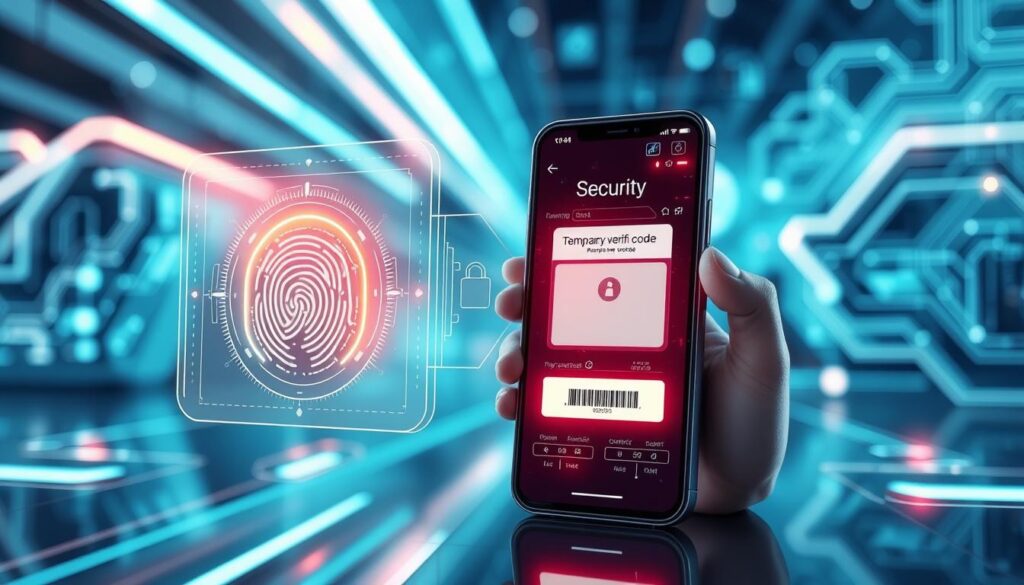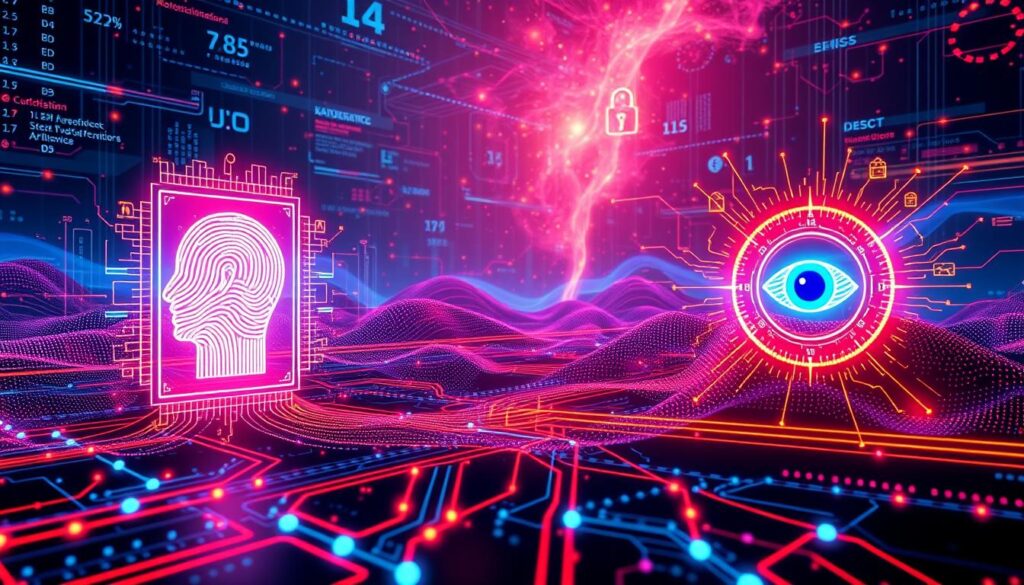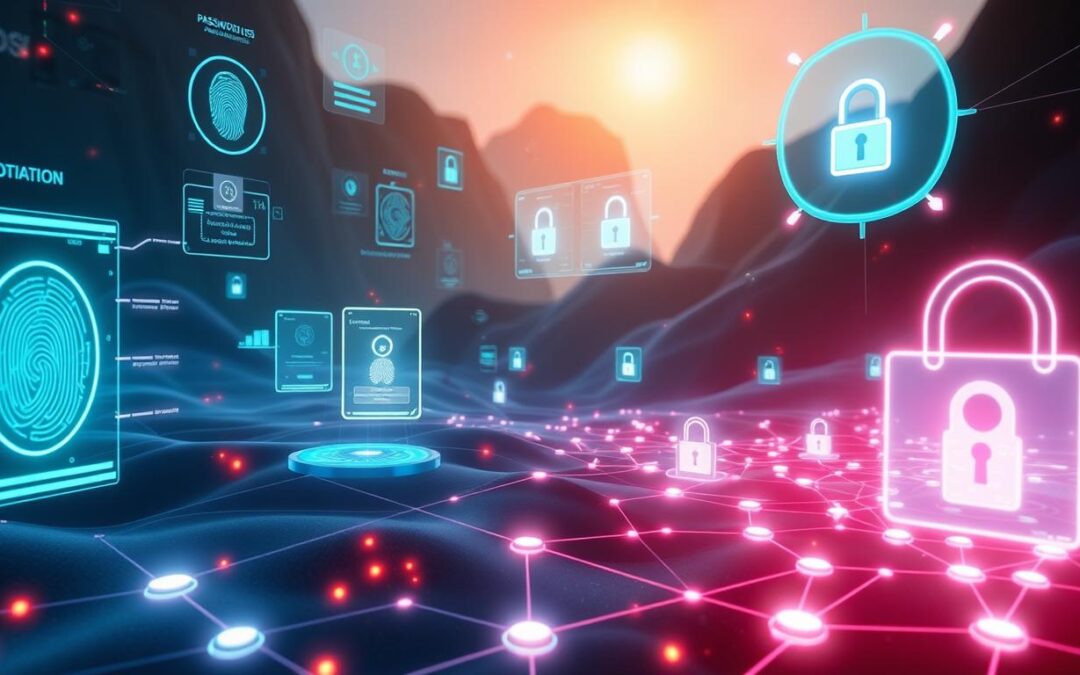In today’s digital world, passwords are no longer enough. Cyber threats keep growing, making us look for better ways to keep our digital lives safe. New methods are coming that offer more security, are easier to use, and protect our online identities better.
Passwordless authentication is changing how we keep our digital stuff safe. It uses cool tech like biometrics, cryptographic keys, and behavioral analytics. This new way of logging in is not only safer but also makes it easier for us to manage our digital lives.
Key Takeaways
- Passwordless authentication is the future of secure digital access, offering enhanced protection against cyber threats.
- Innovative technologies like biometrics, cryptographic keys, and behavioral analytics are transforming the authentication landscape.
- A passwordless approach prioritizes user experience, providing a more seamless and efficient way to manage digital identities.
- Embracing passwordless solutions is crucial for businesses and individuals to stay ahead of evolving cybersecurity challenges.
- The transition to a passwordless world requires a holistic understanding of the latest authentication trends and best practices.
Why Traditional Passwords Are Becoming Obsolete
In today’s digital world, password vulnerabilities and cybersecurity trends keep changing. The old way of using passwords is no longer enough. It’s clear that we need something better for identity and access management.
Common Password Vulnerabilities
Traditional passwords face many threats, including:
- Brute-force attacks, where hackers guess passwords with tools
- Phishing scams, where people are tricked into sharing their passwords
- Password reuse, where one hacked password can open many accounts
- Shoulder surfing, where passwords are seen by others
The Cost of Password Management
Keeping passwords safe costs a lot for companies. The expenses include:
- IT help for password resets and account unlocks
- Rules and checks for password policies
- The risk of data breaches and the harm to reputation and finances
Password-Related Security Breaches
Big security breaches show how weak passwords are. The Equifax data breach and the Yahoo data breach are examples. They showed how important it is to have better ways to log in.
“The reliance on passwords alone is no longer a viable solution for modern identity and access management.”
The old way of using passwords is not working anymore. We need new ways to keep our digital lives safe. Businesses and people must look for stronger ways to protect against password vulnerabilities and cybersecurity threats.
Biometric Authentication: Leading the Security Revolution
Biometric authentication is changing the game in digital security. It offers a strong and easy-to-use alternative to old password systems. Features like facial recognition and fingerprint scanning use your unique traits to confirm who you are. This makes logging in smooth and boosts security.
Biometrics beat password problems by being unique to each person. Unlike passwords, they can’t be guessed or stolen easily. This makes them a safer choice and makes logging in simpler, without the hassle of remembering complex passwords.
| Biometric Modality | Advantages | Disadvantages |
|---|---|---|
| Facial Recognition |
|
|
| Fingerprint Scanning |
|
|
Companies are now focusing on biometric authentication to boost security and user experience. By using biometric technologies, they can protect their digital assets. This also leads to happier users and increased loyalty.
“Biometric authentication is the future of secure and convenient access, transforming the way we interact with digital systems.”
Beyond Passwords: The Future of Authentication in a Passwordless World
The digital world is changing fast, making old password systems outdated. People and businesses want better ways to keep their data safe. Now, we see how passwordless solutions are shaping the future, blending security with ease of use.
Current State of Passwordless Solutions
New ways to log in, like biometrics and hardware keys, are becoming popular. These methods use face scans, fingerprints, and digital keys to confirm who you are. They make logging in easier and safer, without the need for many passwords.
Market Adoption Trends
More companies are moving to passwordless systems, with big tech leaders leading the way. A recent study shows the global market for passwordless login could grow by 35% from 2021 to 2026. Businesses see the benefits, like saving on IT costs and better security against hackers.
Implementation Challenges
Switching to passwordless systems isn’t easy. It’s hard to fit new methods into old systems and meet rules. But, with standards like FIDO2 and WebAuthn, and zero trust security, the future looks brighter.
“The future of authentication is passwordless, and organizations that embrace this shift will gain a competitive edge in safeguarding their digital assets and enhancing customer trust.”
Multi-Factor Authentication: Building Stronger Security Layers
Today, we face more cybersecurity threats than ever. That’s why we need strong ways to check who we are. Multi-factor authentication (MFA) is a key solution, adding security beyond just passwords.
MFA asks for more than one thing to prove who you are. This could be a password, a scan of your face, or a special code. It makes it much harder for hackers to get in, which is why it’s so important for keeping our data safe.
The FIDO Alliance is leading the way in making authentication better. They’ve created standards like WebAuthn and FIDO2. These help make multi-factor authentication work smoothly across different apps and websites, giving everyone a safer online experience.
| Benefits of Multi-Factor Authentication | Challenges of Implementation |
|---|---|
|
|
As we work to keep our digital world safe, using multi-factor authentication is a big step. It helps protect our digital assets and keeps our identities safe online.

FIDO2 and WebAuthn: The New Authentication Standards
FIDO2 and WebAuthn are leading the way to a future without passwords. These new standards are changing how we log into our online accounts. They offer better security and make it easier for users to access their accounts.
How FIDO2 Works
FIDO2 is a joint project by the FIDO Alliance and the World Wide Web Consortium (W3C). It uses public-key cryptography for authentication. Users can log in with devices like biometric sensors, security keys, or built-in authenticators, not just passwords.
WebAuthn Implementation Benefits
- Improved security: FIDO2 and WebAuthn reduce risks like phishing and password leaks.
- Enhanced user experience: They make logging in easier and more convenient, boosting customer satisfaction.
- Increased compliance: These standards meet the latest security rules, helping companies stay compliant.
Success Stories and Case Studies
Many big names have adopted FIDO2 and WebAuthn for better security. For instance, Microsoft uses FIDO2 in Azure Active Directory and Windows Hello for passwordless logins. Google also supports WebAuthn in Chrome, making it easy to log in without passwords across Google services.
“The adoption of FIDO2 and WebAuthn standards is a crucial step in the journey towards a passwordless future, providing a secure and user-friendly authentication experience for organizations and their customers.”
Zero Trust Security Framework in Modern Authentication
The world of cybersecurity is changing fast. Passwords are no longer enough to keep us safe. The zero-trust security framework is changing how we think about keeping data safe. It focuses on the user, not just the network.
This new way of thinking says “never trust, always verify.” It doesn’t assume everyone inside the network is safe. Instead, it checks everyone and everything all the time. This makes data safer and reduces the chance of hackers getting in.
Zero-trust works well with new ways of logging in without passwords. It uses things like face scans and special keys to make logging in easier and safer. This makes it better for both customers and employees.
| Benefits of Zero Trust Security | Challenges in Implementation |
|---|---|
|
|
As technology keeps getting better, using zero-trust security will be key. It helps keep data safe and keeps organizations ahead of threats.
“The zero-trust security model is a game-changer in the world of cybersecurity, providing a more robust and user-friendly approach to authentication and access management.”
Blockchain-Based Identity Management Solutions
The world is getting more digital, making secure identity management key. Old ways like passwords are no longer safe against cyber threats. But, blockchain technology is a new hope.
Decentralized Identity Verification
Blockchain lets people control their own digital identity. It uses blockchain technology to create a secure, portable identity. This way, users can manage their data better, cutting down on identity theft risks.
Smart Contract Authentication
Smart contracts are another big step in identity management. They are digital agreements that check and confirm identities. They can handle tasks like issuing digital IDs and checking user credentials. This makes identity verification strong and safe, moving away from old password systems.
Blockchain’s openness, stability, and shared nature help create better identity systems. As blockchain technology gets more popular, we’ll see more of these systems soon.
The Role of AI in Next-Generation Authentication
In the world of cybersecurity, artificial intelligence (AI) is changing the game in authentication. As artificial intelligence gets better, it’s set to change how we do frictionless authentication and improve cybersecurity trends.
AI is making authentication smarter with intelligent biometric systems. These systems use machine learning to recognize unique patterns, like faces or voices. This makes authentication more secure and easier for users, unlike old password methods.
AI also helps spot unusual user behavior with anomaly detection algorithms. This lets organizations catch and stop security threats early. It helps keep them safe from cybercriminals and strengthens their cybersecurity posture.
| AI-Powered Authentication Features | Benefits |
|---|---|
| Biometric recognition | Improved security and user experience |
| Behavioral analytics | Real-time threat detection and prevention |
| Adaptive risk-based authentication | Contextual security and seamless access control |
As more organizations use artificial intelligence for authentication, security will improve a lot. Users will get a better, more frictionless authentication experience. AI and authentication together are shaping the future of cybersecurity trends, bringing secure and easy access solutions.

Privacy Concerns and Regulatory Compliance
The world is moving towards better ways to verify identities, but privacy worries are growing. People are cautious about sharing their personal data and fear it could be misused. This has led to strict rules like the General Data Protection Regulation (GDPR) to protect user information.
GDPR and Authentication
The GDPR has made things harder for companies in the authentication field. They must find a way to keep data safe while also respecting user privacy. It’s a tough task to meet GDPR standards and still make things easy for users.
Balancing Security with Privacy
Finding a balance between keeping data safe and respecting privacy is key. Users need to trust that their personal info is secure. By focusing on privacy and showing they care about data protection, companies can win user trust and succeed in the future.
FAQ
What are the common vulnerabilities of traditional passwords?
Traditional passwords face many issues. They can be weak and easy to guess. People often use the same password for many accounts. Phishing attacks and data breaches can also expose passwords.
Why is password management so costly for organizations?
Managing passwords costs a lot for companies. It takes time and resources for resets and IT support. Security breaches can lead to big losses and fines.
How do biometric authentication methods improve security and user experience?
Biometrics like facial recognition and fingerprint scanning are better than passwords. They are unique to each person, making them hard to steal. They also make logging in easy and smooth.
What are the current trends in the adoption of passwordless solutions?
More companies are moving to passwordless solutions. They see the benefits of better security and easier use. New trends include more market acceptance and the use of FIDO2 and WebAuthn.
How does multi-factor authentication enhance security layers?
Multi-factor authentication (MFA) adds an extra layer of security. It requires more than one form of ID, like a password and a code sent to a device. This makes it harder for unauthorized access.
What are the key benefits of FIDO2 and WebAuthn standards?
FIDO2 and WebAuthn are open standards for passwordless, multi-factor authentication. They offer better security and eliminate password management. Users find them easy to use, thanks to biometrics or security keys.
How does the zero-trust security framework integrate with modern authentication methods?
The zero-trust model checks user identity and device integrity all the time. It doesn’t rely on just one thing like a password. Passwordless and multi-factor authentication fit well with this model, making identity verification stronger.
How can blockchain technology contribute to decentralized identity management?
Blockchain-based identity management is decentralized. It lets users control their digital identities. It uses self-sovereign identity and smart contracts for secure, private authentication without needing a central authority.
What is the role of AI in the future of authentication?
AI is changing authentication for the better. It makes security smarter and more user-friendly. AI can use behavioral biometrics and anomaly detection for continuous, seamless verification.
How can organizations balance security and privacy concerns in authentication?
It’s important to balance security and privacy in authentication. Companies must use methods that protect user privacy and follow data protection laws. This ensures strong security without compromising personal data.

